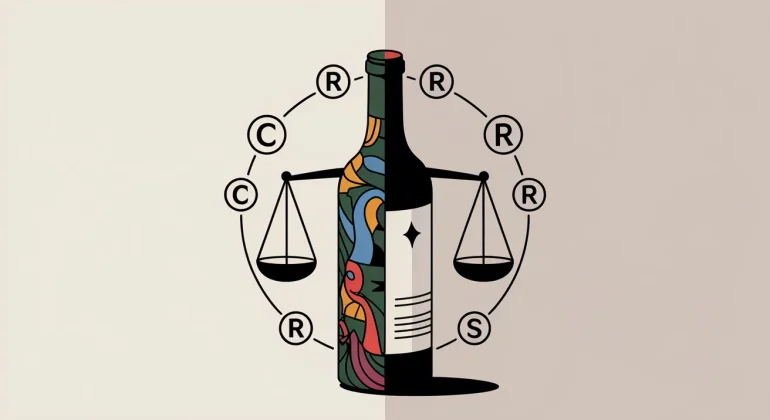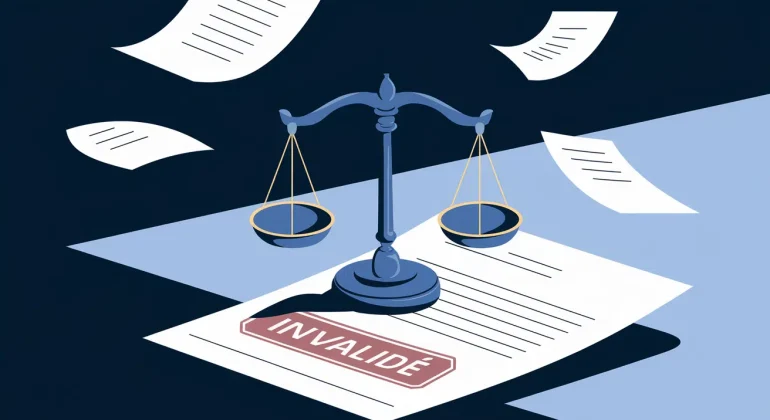In the ever-changing world of intellectual property, trademarks are strategic assets that distinguish products and services in the marketplace. However, their value lies not only in their registration, but also in the vigilance shown by their owners to prevent unauthorized use. One of the major legal pitfalls in this regard is foreclosure by tolerance, a mechanism that can deprive the owner of their rights if they fail to act within the prescribed time limits.
Forfeiture by tolerance cannot be equated with prescription. Forfeiture is based on the voluntary inaction of the trademark owner, whereas prescription is a rule of common law linked to time. Forfeiture prevents any action for invalidity or infringement, even if the facts are recent.
I – Understanding forfeiture by tolerance in trademark law
Definition and legal framework
Laches refers to a situation in which the owner of an earlier trademark knowingly tolerates, for a continuous period of five years, the use of a later registered trademark without taking any action. In European law, Article 61 of the EU Trademark Regulation (EUTMR) codifies this mechanism:
“1. The owner of a trademark of theEuropean Union who has, for five consecutive years, tolerated the use of a later European Union trademark in the European Union while being aware of that use may no longer apply for a declaration of invalidity of the later trademark on the basis of the earlier trademark for the goods or services for which the later trademark has been used, unless the registration of the later European Union trademark was made in bad faith.
- The proprietor of an earlier national trademark referred to in Article 8(2) or of another earlier sign referred to in Article 8(4) who has, for five consecutive years, tolerated the use of a later EU trademark in the Member State where that earlier trademark or other earlier sign is protected, while being aware of that use, may no longer apply for a declaration of invalidity of the later trade mark on the basis of the earlier trade mark or the other earlier sign in respect of the goods or services for which the later trade mark has been used, unless the registration of the later EU trade mark was made in bad faith.
- In the cases referred to in paragraphs 1 or 2, the proprietor of the later European Union trademark may not oppose the use of the earlier right, even if that right can no longer be invoked against the later European Union trademark.
Where the conditions are met, the person who has tolerated the use may no longer contest the validity of the later trademark or prohibit its use.
Essential conditions for forfeiture
For forfeiture by tolerance to occur, four cumulative conditions must be met:
- Knowledge: the proprietor of the earlier trademark must have been aware of the use of the later trademark.
- Continuous use: the later trademark must have been used continuously for five years.
- Good faith: the later trademark must have been registered and used in good faith.
- Absence of legal action: no legal action must have been taken during this period.
Clarification of the concept of “knowledge”
The condition of actual knowledge by the owner of the earlier trademark is a central criterion for forfeiture by acquiescence, but also one of the most debated.
According to the settled case law of the General Court of the European Union (Case T-150/17) and the Court of Justice of the European Union (Case C-381/12 P), knowledge must be actual, not merely presumed. In other words, implicit knowledge or knowledge inferred from the behavior of the proprietor is not sufficient. Proof of actual knowledge of the use of the later trademark is required.
In particular, the Court of Justice recalled in judgment C-381/12 P that:
“The proprietor of an earlier trademark cannot be regarded as having had knowledge of the use of a later trademark unless he actually had knowledge of that use, and not merely implicit knowledge or knowledge inferred from the behavior of the proprietor of the trademark.”
Similarly, the European Union Court of Justice in case T-150/17 clarified:
“Consequently, the proprietor of a trade mark challenged by a declaration of invalidity cannot merely prove potential knowledge of the use of his trade mark by the proprietor of an earlier trade mark, nor can he adduce consistent evidence capable of giving rise to a presumption of such knowledge.”
It is therefore not sufficient that the later trademark is visible on the market or that there are infringement proceedings in other jurisdictions. For example, the mere presence of the disputed trademark in the results of an automated monitoring system does not constitute sufficient evidence in the absence of other concrete evidence.
However, evidence of actual knowledge may result from:
- correspondence between the parties referring to the use of the trademark;
- joint presence at trade fairs where the trademarks are used;
- or the signing of a prior coexistence agreement (case 3971 C).
In case R 1299/2007-2, the EUIPO clarified an important point concerning the condition of knowledge in the context of estoppel by acquiescence. It ruled that the proprietor of the earlier trademark does not need to be aware of the registration of the later trademark, i.e., it is not necessary for them to have formal knowledge that the later trademark has been filed or registered with the competent office. However, it is essential that the proprietor of the earlier trademark has actual knowledge of the use of the later trademark during the relevant period, i.e., that they know that the trademark is being used on the market, despite its registration.
Thus, the period of tolerance begins to run only from the moment when the proprietor of the earlier trademark has actual and objective knowledge of the use of the later trademark, and not simply of its existence as a filing or administrative registration, for five consecutive years. The Board of Appeal ruled, in particular:
“What is important in this context is the objective circumstance that the sign (the use of which was knowingly tolerated by the applicant for annulment) must have existed for at least five years as a Community trademark (CTM).”
II – Risks associated with failure to defend trademark rights
Legal consequences
Failure to take timely action against the unauthorized use of an identical or similar trademark may result in a permanent loss of rights. Once the right has been forfeited through tolerance, the prior owner can no longer bring an action for invalidity or infringement against the later trademark for the products or services concerned. This legal barrier requires absolute responsiveness in order to maintain the enforceability of one’s rights.
Economic consequences
The economic effects of a failure to defend one’s rights are equally damaging:
- Weakening of the trademark: The coexistence of similar trademarks weakens the uniqueness and symbolic value of the earlier trademark. The strength of a trademark lies largely in its ability to distinguish itself clearly from other signs used by competitors. When a similar trademark is tolerated or left unopposed, this differentiation gradually becomes diluted. The earlier trademark then loses some of its exclusivity, which can alter its symbolic value among consumers and business partners. This deterioration affects not only the qualitative perception of the trademark, but also its commercial strength and its ability to embody the identity and values of the company.
- Consumer confusion: Similar trademarks can confuse the public, undermine trust, and divert sales. Consumers faced with a fragmented range of similar signs may find it difficult to clearly identify the origin of products or services. This uncertainty undermines consumer confidence, which can result in hesitation to purchase or even rejection of the market. Furthermore, confusion may encourage the misuse of the reputation and renown of the earlier trademark by the owners of later trademarks, to the detriment of consumer loyalty to the original trademark.
- Loss of market share: Competitors taking advantage of the similarity may capture a share of the customer base by unfairly benefiting from the reputation of the original trademark. This capture of customers is often based on an illegitimate appropriation of the reputation and marketing efforts of the original owner. The impact is reflected in a decrease in sales and, ultimately, an erosion of the original brand’s competitive position. In a competitive market environment, this loss can permanently undermine the economic and strategic viability of the company.
III – Strategies for active trademark protection
Proactive monitoring and detection
Rigorous market monitoring is essential. The implementation of monitoring systems enables the rapid detection of infringing registrations or uses. Regular audits and analysis of national and international databases are also crucial tools for anticipating litigation.
Legal action and timely responses
As soon as unauthorized use is identified, it is advisable to act without delay. This may take the form of:
- formal notices (see limitations below),
- oppositions to the registration of conflicting trademarks,
- or legal action if necessary.
These measures not only serve to avoid foreclosure, but also strengthen the legitimacy and exclusivity of the trademark.
Interruption of the foreclosure period
The starting point and suspension of the grace period are also the subject of extensive case law.
The CJEU ruling C-482/09 established that simply sending a formal notice is not sufficient to interrupt the foreclosure period, unless this letter leads to a concrete result (e.g., voluntary withdrawal, a coexistence agreement, or the initiation of legal proceedings).
Only administrative or judicial action—such as an action for invalidity before the INPI or the European Union Intellectual Property Office (EUIPO) or an action before the national courts, such as an action for infringement—can effectively interrupt the five-year period.
A recent ruling (Case C-466/20) confirmed that sending an unsuccessful warning, even if it proves clear opposition, is not sufficient to prevent foreclosure if no formal action follows. The Court specifies that:
“Any interpretation of Article 9 of Directive 2008/95 and Articles 54, 110 and 111 of Regulation No 207/2009 as meaning that the sending of a warning letter is sufficient, in itself, to interrupt the limitation period would allow the proprietor of the earlier trademark orother earlier right to circumvent the limitation period by tolerance by repeatedly sending, at intervals of nearly five years, a letter of formal notice. Such a situation would undermine the objectives of the limitation period by tolerance, as recalled in paragraphs 46 to 48 of this judgment, and would deprive that system of its effectiveness.”
This decision highlights the importance of active vigilance and legal responsiveness in the face of unauthorized use of an earlier trademark.
Similarly, the signing of a coexistence agreement interrupts the period of foreclosure by tolerance, thereby suspending the period during which the owner of the earlier trademark could lose its rights due to its tolerance. However, if that agreement is subsequently breached or ceases to have effect, a new period of five years begins to run, provided that the proprietor of the earlier trademark again becomes effectively aware of the use of the later trademark. This rule was clarified by decision R 267/2014-2.
In that case, the Board of Appeal held, inter alia:
“Consequently, since the application for a declaration of invalidity was filed on July 11, 2012, the contested decision correctly concluded that less than five consecutive years had elapsed between the end of the verbal agreement, i.e., from the moment when the applicant for invalidity had the opportunity not to tolerate the use of the contested Community trademark, and the application for a declaration of invalidity. On the other hand, even if it were considered that the verbal agreement between the parties had not been breached and had ended when the proprietor of the Community trademark filed opposition against the Community trademark application ‘BONASYSTEMS’ on February 16, 2010, that verbal agreement should, in the absence of evidence to the contrary, be considered still valid. Consequently, the proprietor of the earlier trade mark is still not in a position to refuse to tolerate the use of the latter Community trade mark in the United Kingdom. It follows that the application for a declaration of acquiescence must be dismissed.
Thus, the period of forfeiture can only be resumed if two conditions are met simultaneously: the effective termination of the coexistence agreement and the prior proprietor’s awareness of the continued use of the later trademark.
Conclusion
Actively defending your trademark is not just a legal obligation: it is a strategic imperative. Knowing and anticipating the effects of foreclosure by tolerance is essential to preserving the value, exclusivity, and integrity of a trademark portfolio. A policy of systematic vigilance, combined with targeted and rapid responses, is the best guarantee for ensuring the longevity of an asset as sensitive as a trademark.
The law firm Dreyfus & Associés assists its clients in managing complex intellectual property cases, offering personalized advice and comprehensive operational support for the complete protection of intellectual property.
Dreyfus & Associés is partnered with a global network of lawyers specializing in intellectual property.
Nathalie Dreyfus with the assistance of the entire Dreyfus team.
This article was published on the Village Justice website.
FAQ
1. What is foreclosure through tolerance in trademark law?
Foreclosure by tolerance occurs when the owner of an earlier trademark knowingly tolerates the use of a later registered trademark for five consecutive years without taking action. After this period, the owner of the earlier trademark can no longer seek to invalidate the later trademark, unless it was registered in bad faith.
2. What are the essential conditions for foreclosure by tolerance?
To trigger foreclosure by tolerance, four conditions must be met: the trademark owner must have knowledge of the use of the later trademark, the later trademark must have been used continuously for five years, the later trademark must have been used in good faith, and no legal action must have been taken during this period.
3. What are the legal consequences of not defending your trademark in time?
Failing to act against unauthorized use of a trademark within the prescribed period can result in a permanent loss of rights. Once foreclosure by tolerance is established, the owner can no longer challenge the validity or prevent the use of the later trademark for the relevant products or services.











